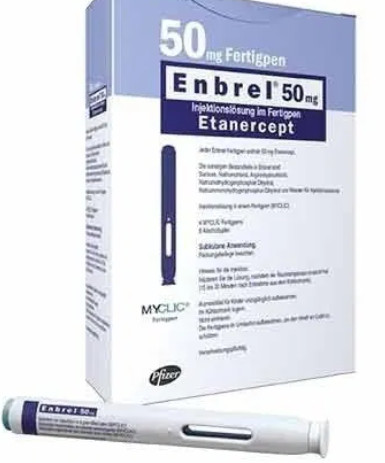
Indications of etanercept in dermatology
- FDA approaved
- Plaque psoriasis.
- Psoriatic arthritis.
- Off-label use
- Pemphigus vulgaris.
- Pityriasis rubra pilaris.
- SAPHO syndrome
- Necrobiosis lipoidica.
- Acrodermatitis continua of Hallopeau.
- Graft-versus-host disease.
- Pyoderma gangrenosum, refractory.
- Aphthous stomatitis.
- Behçet’s disease:25 mg twice weekly.
- Hidradenitis suppurativa.
- Eosinophilic fasciitis.
- Dermatomyositis.
- Palmoplantar pustulosis.
- Erythema nodosum.
- Cutaneous granulomas.
- Atopic dermatitis.
- Toxic epidermal necrolysis.
Dosage
- Psoriatic arthritis: Once-weekly dosing: 50 mg once weekly
- Acute graft-versus-host disease: 0.4 mg/kg (maximum: 25 mg/dose) twice weekly for 8 weeks (in combination with methylprednisolone).
- Chronic graft-versus-host disease (refractory), treatment: SubQ: 25 mg twice weekly for 4 weeks, followed by 25 mg once weekly for 4 weeks (in combination with corticosteroids and/or immunosuppressive therapy).
- Plaque psoriasis:
- 50 mg twice weekly SC for 3 months (starting doses of 25 or 50 mg once weekly have also been used ).
- Maintenance dose: 50 mg once weekly.
- Plaque psoriasis: Children and Adolescents 4 to 17 years Enbrel: SubQ: 0.8 mg/kg/dose once weekly; maximum dose: 50 mg/dose.
- Pyoderma gangrenosum, refractory :): SubQ: 25 to 50 mg SC twice weekly.
- Pemphigus vulgaris: 25–50 mg twice weekly for 4 months.
- Pityriasis rubra pilaris: 50 mg weekly for 5 months.
- Behçet’s disease: 25 mg twice weekly.
Mechanism of action
- Etanercept is anti-tumor necrosis factor (anti-TNF) agent that binds and inhibits the activity of TNF.
- It inhibits soluble and membrane-bound TNF-α.
Baseline Monitoring
- Ask about:
- Personal and family history closely for multiple sclerosis and related demyelinating disorders.
- Labs
- PPD.
- Chest x ray in selective cases.
- CBC.
- LFT.
Follow Up Monitoring
- Periodic skin examinations in all patients during therapy, particularly those at increased risk of skin cancer.
- PPD: 6- to 12-month intervals (QuantiFERON-TB Gold testing (interferon-gamma release assay) may be a more appropriate primary test in patients with risk factors for false-negative tuberculin skin test results.
- LFT
Side effects of etanercept
- COMMON
- Injection site reactions: Use Cool compresses and 1% hydrocortisone ointment.
- Upper respiratory infection.
- RARE
- Reactivation tuberculosis.
- Malignancy.
- Alopecia.
- Spessis.
- Anaphylaxis/hypersensitivity reactions.
- Lupus-like syndrome or autoimmune hepatitis.
- Demyelinating CNS disease.
- Heart failure.
- Pancytopenia (rare).
- Reactivation of hepatitis B (rare).
- Myelitis, optic neuritis, pharyngitis, headache, rhinitis, abdominal pain, nausea, vomiting, rash.
Contraindications
- Hypersensitivity to etanercept or any component of the formulation
- Patients at risk of sepsis syndrome (eg, immunocompromised, HIV positive).
- Concurrent administration with anakinra.
- Family history of demyelinating diseases.
Interactions of etanercept
- Risk of infections: immunosuppressants.
- Avoid combination with
- Abatacept
- Anakinra
- DMARDs
- Cyclophosphamide
- Tacrolimus (Topical)
- Intravesical BCG
- Belimumab
- Canakinumab
- Certolizumab Pegol
- Cladribine
- Tocilizumab
- Etanercept + methotrexate is approved for the treatment of rheumatoid arthritis and psoriatic arthritis.
Pregnancy & Lactation
- Pregnancy Category B
- Consider discontinuing etanercept 15 days prior to attempting pregnancy
- The American Academy of Dermatology considers TNFα blocking agents for the treatment of psoriasis to be compatible with pregnancy and breastfeeding.
- Etanercept and other TNF inhibitors be avoided after the first trimester.
- Tumor necrosis factor alpha (TNFα) blocking agents are considered to have low to moderate risk when used in pregnancy.
- Neonate/infant should be considered immunosuppressed for 1 to 3 months following in utero exposure.
- Etanercept is minimally excreted in breast milk.
- For more information
Precautions
- Discontinue etanercept if a patient develops a serious infection or sepsis.
- Consider empiric antifungal therapy in patients at risk for invasive fungal infections who develop severe systemic illness.
- Do not initiate etanercept therapy in patients with an active infection, including clinically important localized infection
- Patients with initial negative tuberculin skin tests should receive continued monitoring for tuberculosis during and after treatment.
- Use with caution in patients with moderate to severe alcoholic hepatitis.
- Use with caution in patients with a history of seizures.
- Malignancies have been reported among children and adolescents.
- Use with caution in elderly patients.
- Patients should be brought up to date with all immunizations before initiating therapy.
- Monitor signs/symptoms of malignancy (eg, splenomegaly, hepatomegaly, abdominal pain, persistent fever, night sweats, weight loss).
Drug Info
- Etanercept is a fusion protein containing the TNF‐α receptor (TNFαRII) fused with a humanized immunoglobulin fragment.
- Etanercept has been used together with narrowband UVB without an increase in adverse events.
#Etanercept